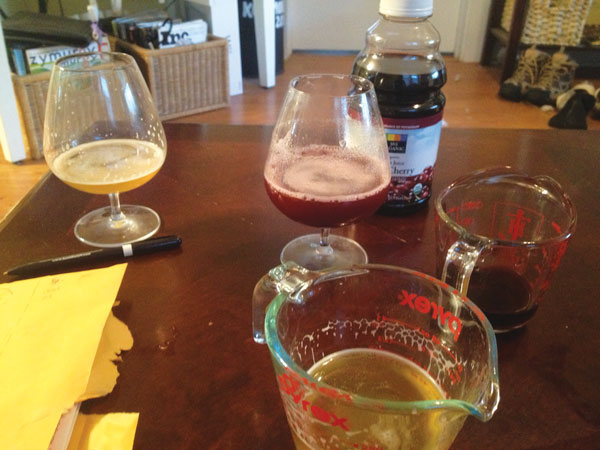Blending Fruit Wine in Beer
TroubleShooting
Spencer Howard — Chattanooga, Tennessee asks,
I bottle condition all my homebrewed beers, which are typically sours and Belgian styles. We also make wine and have several plum and cherry trees and a Siberian kiwi vine. To bulk process fruit during harvest season, I will often ferment the fruit in a 5-gallon (19-L) bucket with a champagne and sour yeast, such as Lallemand Philly Sour, and then bottle it. I then age it. It is good as is, but I would like to blend it with other beers and was thinking to pour some into bottles when I am bottling another batch. But I wasn’t sure if there is a better way. Some of the fermented plum bottles are several years old and have really developed a neat flavor.
Sounds like you have access to some great stuff! Love the idea of blending fruit wine into beer and hope to give you some ideas on how to make this practical. Perhaps the easiest thing to do given the volume of fruit wine you seem to produce would be to use glass carboys to store and age your collection of blending wines for later use in brewing and bottling what you don’t use. I can see how this idea may not be as flexible as using bottled product when you decide to use it, but it would reduce the complexity of “unbottling” and less prone to oxidation compared to pouring bottles of fruit wine into beer during blending. If this sounds like something practical, there is a lot written about how wine in carboys is used to top up barrels during aging and how to protect wine in glass from oxidation during this process.
I do like your idea of grabbing bottles of sour plum, sweet cherry, and dry cherry-kiwi fruit wine, for example, and blending into something like a Russian imperial stout before bottling. A relatively easy method to move your wine from glass to beer is to use a counter-pressure bottle filler in reverse. Assuming you have determined the blend and are ready to start the process, begin by racking your base beer, the Russian imperial stout in this example, into a bottle container. Cornelius kegs are really the ideal vessel for the task.

Blending beer with fruit juices and wine can yield amazing results. The key to doing it right is through blending trials to find the best ratios of each. Photo by Kyle Kohlmorgen
Begin by filling a Corny keg with a no-rinse sanitizer like Star San, push the sanitizer out of your keg with carbon dioxide, and rack your beer into the keg through the “out” connection on the keg while venting the gas out of the keg through the pressure relief valve. Now you’re ready for the wine addition. Because kegs are not clear, it’s important to know that there is sufficient headspace in the keg to accommodate the volume of wine that follows. Call me Mr. Obvious, but this detail should not be overlooked! Another important detail is to open the keg’s pressure relief valve and leave it open until the next step of the process is complete.
Reverse filling a bottle, aka dispensing like a beer keg, is simple if you have the right sort of filler. Simply connect the fill tube of your bottle filler to the “in” post on your keg and the filler’s carbon dioxide tube to a CO2 regulator set to about 2 psi, as if you are preparing to fill. Open one of the bottles destined for the base beer, insert the fill tube into the bottle, open the gas valve on the filler as if you were planning to pressurize before filling, and you are now pushing wine out of the bottle and into the keg of beer with a nice CO2 headspace. Except in this scenario, the gas valve remains open until the CO2 has displaced the wine into the beer.
Now what?
I have assumed that the blend was determined before the mixing process above occurred. But this does not mean that tasting is not needed. At this stage of the game, close the pressure relief valve on your keg, add enough CO2 pressure to seal the lid, invert a couple of times to mix, and take a small sample. If the blend tastes as expected, you have a few options. Depending on what you are producing, you could force carbonate and put the beer on tap, force carbonate and counter-pressure fill into bottles, or add some priming sugar and a fresh dose of priming yeast prior to bottling. Thank you for the fun question!
